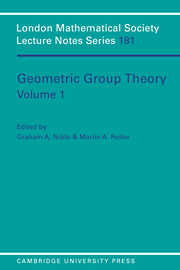Book contents
- Frontmatter
- Contents
- Preface
- List of Participants
- 1 Group Actions and Riemann Surfaces
- 2 The Virtual Cohomological Dimension of Coxeter Groups
- 3 The Geometric Invariants of a Group A Survey with Emphasis on the Homotopical Approach
- 4 String Rewriting — A Survey for Group Theorists
- 5 One Relator Products and High-Powered Relators
- 6 An Inaccessible Group
- 7 Isoperimetric and Isodiametric Functions of Finite Presentations
- 8 On Hibert's Metric for Simplices
- 9 Software for Automatic Groups, Isomorphism Testing and Finitely Presented Groups
- 10 Proving Certain Groups Infinite
- 11 Some Applications of Small Cancellation Theory to One-Relator Groups and One-Relator Products
- 12 A Group Theoretic Proof of the Torus Theorem
- 13 N-Torsion and Applications
- 14 Surface Groups and Quasi-Convexity
- 15 Constructing Group Actions on Trees
- 16 Brick's Quasi Simple Filtrations and 3-Manifolds
- 17 A Note on Accessibility
- 18 Geometric Group Theory 1991 Problem List
12 - A Group Theoretic Proof of the Torus Theorem
Published online by Cambridge University Press: 15 March 2010
- Frontmatter
- Contents
- Preface
- List of Participants
- 1 Group Actions and Riemann Surfaces
- 2 The Virtual Cohomological Dimension of Coxeter Groups
- 3 The Geometric Invariants of a Group A Survey with Emphasis on the Homotopical Approach
- 4 String Rewriting — A Survey for Group Theorists
- 5 One Relator Products and High-Powered Relators
- 6 An Inaccessible Group
- 7 Isoperimetric and Isodiametric Functions of Finite Presentations
- 8 On Hibert's Metric for Simplices
- 9 Software for Automatic Groups, Isomorphism Testing and Finitely Presented Groups
- 10 Proving Certain Groups Infinite
- 11 Some Applications of Small Cancellation Theory to One-Relator Groups and One-Relator Products
- 12 A Group Theoretic Proof of the Torus Theorem
- 13 N-Torsion and Applications
- 14 Surface Groups and Quasi-Convexity
- 15 Constructing Group Actions on Trees
- 16 Brick's Quasi Simple Filtrations and 3-Manifolds
- 17 A Note on Accessibility
- 18 Geometric Group Theory 1991 Problem List
Summary
Introduction
The Torus Theorem was discovered by Waldhausen and subsequently several authors, including Jaco, Shalen, Johannson and Scott gave proofs of various forms of the Theorem. In its most general form, it identifies a characteristic submanifold within a compact 3-manifold, and provides a canonical decomposition of the 3-manifold into pieces which, according to Thurston's Geometrization Conjecture, admit a geometric structure based on one of eight 3-dimensional geometries. Although Thurston's Conjecture is not at present completely proved, much of it has been proved and it has therefore been clear for several years that the Torus Theorem and its generalizations are of fundamental importance.
The early approaches to proving the Torus Theorem involved quite intricate geometric or topological arguments. Of these, Scott's account [22] and [24] is amongst the most easily digestible and indicates that much of the Theorem depends solely on properties of the fundamental group.
Nowadays any approach to studying a compact 3-manifold M begins by assuming that M is endowed with either a PL or with a smooth structure. It is known that every topological 3-manifold admits both a unique PL and a unique smooth structure, and we shall make no further comment on this part of the theory. A modern approach to the Torus Theorem can begin in one of two ways. Working with the smooth structure, Casson now has a very elegant geometric proof which uses least area surface methods developed by Scott. On the other hand, as we shall demonstrate in this article, one can also work almost entirely with the fundamental group. From this second point of view it is natural to think in terms of the PL structure.
- Type
- Chapter
- Information
- Geometric Group Theory , pp. 138 - 158Publisher: Cambridge University PressPrint publication year: 1993
- 8
- Cited by

